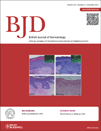Comparison between autologous noncultured epidermal cell suspension and suction blister epidermal grafting in stable vitiligo: a randomized study
Funding sources None.
Conflicts of interest None declared.
Summary
Background Vitiligo is an acquired disorder of pigmentation due to loss of epidermal melanocytes. Autologous noncultured epidermal cell suspension (NCES; a cellular grafting technique) and suction blister epidermal grafting (SBEG; a tissue grafting technique) are important established surgical modalities for the treatment of stable vitiligo.
Objectives To compare the two techniques, NCES and SBEG, for producing repigmentation in patients with stable vitiligo.
Methods We randomized 41 patients with 54 stable vitiligo lesions into two groups. Patients in group 1 were treated with NCES, and those in group 2 with SBEG. They were evaluated 16 weeks postsurgery for the extent of repigmentation, colour match, change in Dermatology Life Quality Index (DLQI) score and patient satisfaction.
Results The extent of repigmentation was excellent (showing 90–100% repigmentation) in 71% of lesions in the NCES group and 27% of lesions in the SBEG group (P = 0·002). Repigmentation ≥ 75% (good repigmentation) was observed in 89% of lesions in the NCES group and 85% of lesions in the SBEG group (P = 0·61). There was a significant decline in DLQI score in both the groups; the mean decline among groups differed significantly (P = 0·045). No significant difference was seen in colour match and pattern of repigmentation. Adverse effects were minimal.
Conclusions NCES is significantly better than SBEG and should be the preferred treatment for patients with stable vitiligo. To best of our knowledge, this is the first study directly comparing these two techniques.




